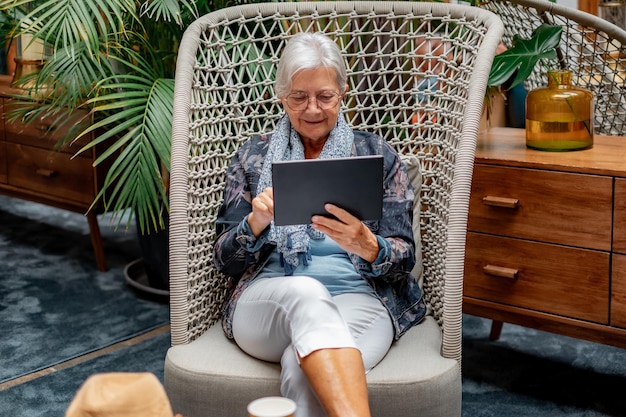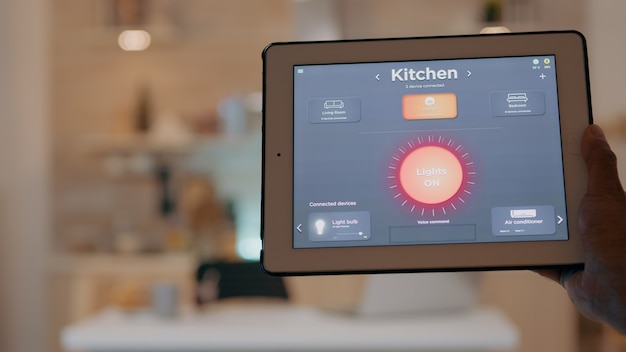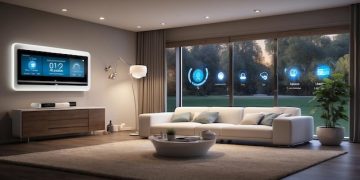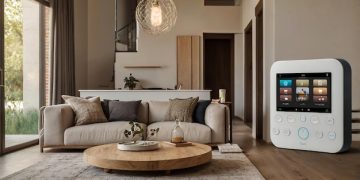Aging in Place: Smart Technologies for Seniors After 65

Aging in place leverages smart technologies to enable seniors over 65 to maintain independence and quality of life in their own homes, enhancing safety, connectivity, and overall well-being.
Aging in place is becoming increasingly feasible and attractive for seniors, thanks to the rapid advancements in smart technology. These innovations not only enhance the safety and security of older adults but also promote their independence and overall quality of life. Let’s explore how smart technologies are revolutionizing independent living after 65.
Understanding Aging in Place and Its Benefits
Aging in place refers to the ability of seniors to live in their own homes and communities safely, independently, and comfortably, regardless of age, income, or ability level. This concept is gaining traction as more older adults prefer to remain in familiar surroundings rather than move to assisted living facilities.
The appeal of aging in place is rooted in the desire for autonomy and familiarity. Staying at home allows seniors to maintain their social connections, routines, and sense of identity, all of which contribute to their emotional and psychological well-being.
The Emotional and Psychological Advantages
Remaining in a familiar environment brings numerous emotional and psychological benefits. Seniors often have deep attachments to their homes, filled with memories and personal meaning. This connection can provide a sense of security and continuity during a time of significant life transitions.
Social Connections and Community Engagement
Aging in place enables seniors to stay connected with their local communities, friends, and family. These relationships are essential for combating social isolation and loneliness, which can have detrimental effects on mental and physical health.
- Maintaining social networks through regular visits and community activities.
- Participating in local events and volunteer opportunities.
- Utilizing transportation services to access community resources.
Smart technologies play a crucial role in supporting these aspects of aging in place, offering solutions that enhance safety, connectivity, and overall well-being. By leveraging these advancements, seniors can enjoy a higher quality of life while remaining independent in their own homes.
In conclusion, understanding the concept of aging in place and its multifaceted benefits is essential for appreciating the role of smart technologies in making this option viable and attractive for older adults. The emotional, psychological, and social advantages of staying at home contribute significantly to the overall well-being of seniors.
Smart Home Technology for Safety and Security
One of the primary concerns for seniors aging in place is safety and security. Smart home technology offers a range of solutions designed to mitigate these risks, providing peace of mind for both seniors and their families. These technologies can help prevent accidents, detect emergencies, and ensure timely assistance.
From smart security systems to fall detection devices, the options are diverse and can be tailored to meet individual needs. By integrating these technologies into their homes, seniors can create a safer and more secure living environment.

Smart Security Systems
Smart security systems provide enhanced protection against intruders and can alert emergency services in case of a break-in. These systems often include features such as door and window sensors, motion detectors, and video surveillance, all of which can be monitored remotely.
Fall Detection and Emergency Alerts
Falls are a leading cause of injury among older adults, and prompt assistance is crucial in such situations. Fall detection devices, such as wearable sensors and smart floor mats, can automatically detect falls and send alerts to caregivers or emergency services.
- Wearable fall detection devices that automatically call for help.
- Smart floor mats that detect falls and unusual activity.
- Emergency alert systems with one-touch access to assistance.
These technologies not only enhance the safety and security of seniors but also provide a sense of independence and control. By addressing potential risks proactively, smart home technology empowers older adults to live more confidently in their own homes.
In summary, smart home technology offers a comprehensive approach to enhancing safety and security for seniors aging in place. From smart security systems to fall detection devices, these innovations provide peace of mind and empower older adults to live more confidently in their own homes.
Health Monitoring and Remote Care
Maintaining good health is essential for seniors who wish to age in place. Smart technology offers innovative solutions for health monitoring and remote care, enabling seniors to manage their health conditions more effectively and receive timely medical assistance.
These technologies range from wearable health trackers to remote patient monitoring systems, all designed to provide valuable insights into a senior’s health status. By tracking vital signs, medication adherence, and other health-related data, these tools empower seniors to take a proactive role in their own care.
Wearable Health Trackers
Wearable health trackers, such as smartwatches and fitness bands, can monitor a variety of health metrics, including heart rate, sleep patterns, and activity levels. This data can be shared with healthcare providers to facilitate more informed treatment decisions.
Remote Patient Monitoring Systems
Remote patient monitoring systems allow healthcare providers to track a patient’s health status from a distance. These systems often include devices that measure blood pressure, blood glucose levels, and other vital signs, transmitting the data to a central monitoring station.
- Devices for measuring blood pressure and heart rate.
- Glucose monitors for diabetes management.
- Scales for tracking weight and fluid retention.
By leveraging these technologies, seniors can maintain better control over their health and receive timely medical attention when needed. This proactive approach to health management can help prevent complications and improve overall well-being.
In conclusion, health monitoring and remote care technologies are transforming the way seniors manage their health while aging in place. These tools empower older adults to take a proactive role in their own care, improving their overall well-being and quality of life.
Smart Technology for Enhanced Connectivity and Communication
Staying connected with family, friends, and the broader community is crucial for seniors aging in place. Smart technology offers a range of solutions designed to enhance connectivity and communication, combating social isolation and promoting emotional well-being.
From video calling devices to social media platforms, these technologies enable seniors to maintain relationships and engage with the world around them. By leveraging these tools, older adults can stay informed, entertained, and connected to their loved ones.
Video Calling and Communication Devices
Video calling devices make it easy for seniors to stay in touch with family and friends, regardless of distance. These devices often feature simple interfaces, large buttons, and high-quality video and audio, making them accessible to older adults with limited technical skills.
Social Media and Online Communities
Social media platforms and online communities provide opportunities for seniors to connect with like-minded individuals, share experiences, and stay informed about current events. These platforms can help combat social isolation and promote a sense of belonging.

- Social media groups for seniors with shared interests.
- Online forums for discussing health and wellness topics.
- Virtual events and activities for staying engaged and entertained.
By embracing these technologies, seniors can maintain strong social connections and enhance their overall quality of life. Staying connected to the world around them is essential for promoting emotional well-being and preventing social isolation.
In summary, smart technology plays a vital role in enhancing connectivity and communication for seniors aging in place. These tools enable older adults to maintain relationships, engage with the community, and stay informed about the world around them.
Accessibility and Smart Home Automation
Accessibility is a key consideration for seniors aging in place. Smart home automation offers solutions that make homes more accessible and user-friendly, enabling seniors to navigate their living spaces safely and comfortably. These technologies can be customized to meet individual needs, addressing challenges related to mobility, vision, and hearing.
From smart lighting to voice-controlled devices, the options are diverse and can significantly improve the quality of life for older adults. By automating everyday tasks, these technologies reduce the physical and cognitive burden on seniors, allowing them to maintain their independence for longer.
Smart Lighting and Temperature Control
Smart lighting systems can be programmed to adjust automatically based on time of day or occupancy, ensuring that seniors always have adequate lighting to prevent falls and other accidents. Smart thermostats allow seniors to control the temperature of their homes remotely, maintaining a comfortable and safe living environment.
Voice-Controlled Devices
Voice-controlled devices, such as smart speakers, enable seniors to control various aspects of their homes using voice commands. These devices can be used to turn on lights, adjust the temperature, play music, make phone calls, and access information, making it easier for seniors to manage their daily routines.
Smart home automation not only enhances accessibility but also provides a sense of control and independence. By automating everyday tasks, these technologies reduce the physical and cognitive burden on seniors, allowing them to maintain their quality of life for longer.
In conclusion, accessibility and smart home automation are essential components of successful aging in place. These technologies create safer, more comfortable, and more user-friendly living environments, enabling seniors to maintain their independence and quality of life.
Cost Considerations and Financial Planning
While smart technology offers numerous benefits for seniors aging in place, it’s important to consider the associated costs and develop a sound financial plan. The initial investment in smart home devices and installation can be significant, but there are ways to mitigate these expenses and ensure that these technologies are accessible to seniors with varying budgets.
From exploring government assistance programs to prioritizing essential features, careful planning can help seniors make informed decisions about which technologies are right for them. By balancing the benefits of smart technology with the financial realities, seniors can create a sustainable plan for aging in place.
Government Assistance Programs and Grants
Several government assistance programs and grants are available to help seniors cover the costs of home modifications and assistive technologies. These programs may provide financial assistance for installing ramps, grab bars, smart home devices, and other accessibility features.
Prioritizing Essential Features and Budgeting
When planning for smart technology, it’s important to prioritize essential features that address the most pressing needs. For example, seniors with mobility issues may prioritize accessibility features, while those concerned about safety may focus on security systems and fall detection devices.
- Identifying the most critical needs and challenges.
- Researching the costs of different smart technology solutions.
- Creating a budget that aligns with financial resources.
By taking a strategic approach to financial planning, seniors can ensure that smart technology enhances their quality of life without causing undue financial strain. Careful budgeting and exploration of available resources can make these technologies accessible to a wider range of individuals.
In summary, cost considerations and financial planning are essential aspects of integrating smart technology into aging in place strategies. By exploring available resources, prioritizing essential features, and creating a realistic budget, seniors can make smart technology accessible and sustainable.
| Key Feature | Brief Description |
|---|---|
| 🛡️ Smart Security Systems | Enhanced protection with sensors, detectors, and surveillance. |
| ❤️ Health Monitoring | Wearable trackers and remote systems for vital signs. |
| 🗣️ Enhanced Connectivity | Video calls and social platforms combatting isolation. |
| 💡 Smart Automation | Automated lighting, temperature, and voice controls. |
Frequently Asked Questions
Aging in place refers to the ability of seniors to live in their own homes and communities safely, independently, and comfortably, regardless of age or ability level.
Smart technology enhances safety through features like fall detection, emergency alerts, and smart security systems that can quickly respond to potential hazards.
Remote health monitoring allows seniors to track vital signs and health data from home, enabling timely medical intervention and better management of chronic conditions.
Smart home automation improves accessibility by automating tasks like lighting and temperature control, making homes more user-friendly for seniors with mobility or cognitive challenges.
Yes, several government assistance programs and grants are available to help seniors cover the costs of home modifications and assistive technologies, making aging in place more affordable.
Conclusion
In conclusion, smart technologies are transforming the landscape of aging in place, offering seniors a pathway to maintain independence, safety, and quality of life in their own homes. By embracing these innovations, older adults can navigate the challenges of aging with confidence and dignity, ensuring a fulfilling and comfortable later life.





